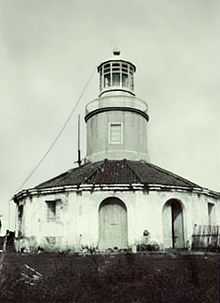Cape Engaño Lighthouse
|
| |
.svg.png) | |
| Location | Palaui Island, Sta. Ana, Cagayan |
|---|---|
| Coordinates | 18°34′47.51″N 122°8′15.68″E / 18.5798639°N 122.1376889°ECoordinates: 18°34′47.51″N 122°8′15.68″E / 18.5798639°N 122.1376889°E |
| Year first constructed | 1892 |
| Year first lit | 1892 |
| Construction | Stone Masonry |
| Tower shape | Octagonal tower in the middle of an enclosed court |
| Markings / pattern | Light gray tower |
| Height | 47 ft (14.3 m) |
| Focal height | 316 ft (96.3 m) |
| Original lens | First-Order Catadioptric lens |
| Current lens | n/a |
| Range | 27 miles |
| Characteristic | One flash and shows double flash every 30 sec |
| Fog signal | none |
| Admiralty number | F2732 |
| NGA number | 14020 |
| ARLHS number | PHI-013[1] |
Cape Engaño Lighthouse, also known as Faro de Cabo Engaño, is a historic lighthouse located at the Palaui Island in the town of Santa Ana, the province of Cagayan, Philippines. Located at the northernmost part of Luzon Island and situated atop the summit of a hill, 92 meters above sea-level, the lighthouse provides a 360-degree view of Babuyan Island and the Dos Hermanas Island (Two Sisters) on the North, Pacific Ocean on the West and Engaño cove on the East.
Cape Engaño Lighthouse is now under the supervision of the Department of Transportation and Communications through the Philippine Coast Guards' lighthouse division.[2]
History
Faro de Cabo Engaño is one of the four lighthouses built during the Spanish Colonial period, which served as gateway lighthouse for incoming ships. The construction started on 21 September 1888 and finished on 31 December 1892, where in most of the laborers are Filipinos.
THE JAMORABON FAMILY
The Cape Engaño Lighthouse become home of the Jamorabons for generations.They also work as lighthouse keeper,namely Gregorio Jamorabon,the longest-servicing lighthouse keeper.The complex used to shelter 7 crew members tasked to maintain the lighthouse. In that time according to Teresa Jamorabon,late wife of Gregorio Jamorabon,the lighthouse is only the place where residents enjoy electricity. Teresa Jamorabon described how well the government took care of the lighthouse keepers and the station.Their rations-rice,beans,noodles,cooking oil and kerosene-arrived every month and were shared equally among the workers,regardless ranks. Imelda Jamorabon-Leaño,Teresa Jamorabon's 8th child,recalled how she and the other worker's children
According to the Jamorabons,the name of the lighthouse was given by Spaniard seafarers when they first set foot on the cape and were so stunned by its natural beauty that they named it "Engaño".[3]
Structure
It is initially designed by Engineer Magin Pers y Pers, who also designed Cape Bojeador and Capones Island but was continued by Guillermo Brockman.
The Lighthouse complex is composed of the housing pavilion (served as an office and workers quarter), the service buildings (served as kitchen and storage) and the 11-meter octagonal tower which houses the crown and the copper lantern (but was now a solar-based lighting mechanism) that is visible in all angles of the lighthouse. This was all built using local materials, masonry and hardwood.[4]
Visiting the Lighthouse

The port of San Vicente in Santa Ana, Cagayan is the only access to Cape Engaño. Coming from Manila, one can take a bus going to Santa Ana or a plane going to Tuguegarao.
Cape Engaño cove and its lighthouse can be reached via direct small boat ride to the cape or via two trails in Palaui Island. First trail is via the Lagunzad trail named after Daniel Lagunzad, a Filipino botanist. The Lagunzad trail primarily passes through Palaui Island's eastern shore and a short grassland and forest trek towards the lighthouse. Second trail is via the Leonardo Trail, named after Leonard Co, also a Filipino botanist. The trail passes through the mountainous area of the island and a side trip can be made to Baratubot Falls.[5]
Once you arrive at the historical lighthouse, one will find that the only remaining intact is the two-foot thick wall, while everything else is destroyed. The provincial government has embarked on a joint restoration project in partnership with the Cagayan Economic Zone Authority and other non-government organizations. [6]


See also
References
- ↑ "Cabo Engaño/Cagayan Light". Amateur Radio Lighthouse Society. Retrieved on 2010-06-27.
- ↑ "Faro de Cabo Engaño". ICOMOS. Retrieved 2 May 2014.
- ↑ "Faro de Cabo Engaño". ICOMOS. Retrieved 2 May 2014.
- ↑ "Faro de Cabo Engano". Filipino Heritage Festivals. Retrieved 2 May 2014.
- ↑ "Palaui Island and the Serene Cape Engano, a mountaineer and a beach bum's Paradise". Schadow1 Expeditions. 3 April 2013. Retrieved 17 January 2015.
- ↑ "Cape Engano". ICOMOS. Retrieved 2 May 2014.
External links
-
 Media related to Cape Engaño Lighthouse at Wikimedia Commons
Media related to Cape Engaño Lighthouse at Wikimedia Commons - Rowlett, Russ. "Lighthouses of the Northern Philippines". The Lighthouse Directory. University of North Carolina at Chapel Hill.
- Light Stations of Northern Luzon at the Philippine Coast Guard Website.
| ||||||||||

